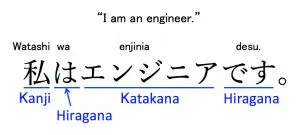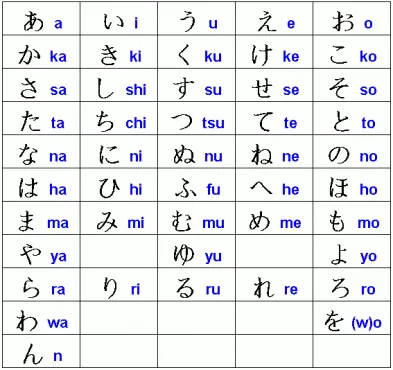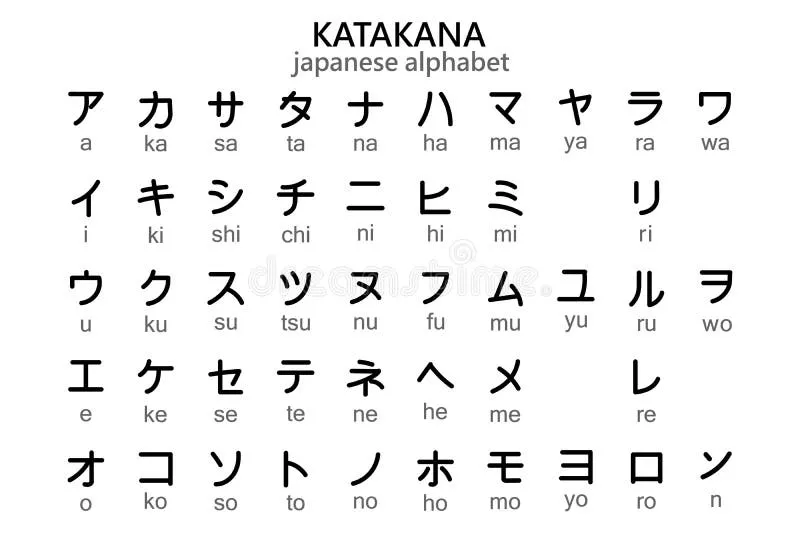Understanding the two main writing systems of Hiragana and Katakana, is a huge challenge while learning the Japanese language. They may initially confuse you as they both represent the same set of sounds, but the difference between Hiragana and Katakana is their use. For the native Japanese Language, grammar, and daily writing, Hiragana is more flexible and often utilised. Conversely, Katakana seems crisper. And it focuses mainly on the emphasis of words, brand names, and foreign words. They both serve as the cornerstone of Japanese literature and provide access to further in-depth language instruction. In this blog, we discuss the difference between Hiragana and Katakana, and how to master them for beginners.
The Origin of Hiragana and Katakana:
Before delving into the two main characters, it is crucial to understand that the Japanese language is a mix of three distinct writing systems, each of it, serves a unique purpose in the language system.
First comes
Hiragana: It is the first and foundational system for native Japanese and grammatical particles.
Then,
Katakana: Katakana is recognised as the foreign loanword system and is renowned for its emphasis and dramatic sounds. The onomatopoeia, scientific terms, and other aspects of the outer world are incorporated into the language.
And at last is,
Kanji: Inspired by Chinese, Kanji, forms entire words and symbolises grammatical concepts. It is used for the symbolisation of characters and to create entire sentences. Learning Kanji can be difficult. Practising gradually after mastering the writing systems of both Hiragana and Katakana is a better way to learn kanji.
Here is an example showing the three writing systems of the Japanese language

Now, let’s see the basics of Hiragana and Katakana for beginners
What are Hiragana and Katakana in the Japanese language?
Hiragana: The Heart of Japanese Language
Hiragana is called as base for the flowing script of the Japanese language. It is the first system of language, a beginner starts his/her learning journey with 46 primary phonetics with different syllables.
Every time hiragana is written in cursive, along with round strokes, it gives them an organic and elegant appearance. A lot of curves, loops, and continuous lines can easily recognise them as Hiragana.
Hiragana represents grammatical particles, which help connect words into a phrase. Words like Wa (は), ga (が), o (を), ni (に), and no (の) are a few examples of Hiragana words that are frequently used, and you cannot frame a sentence without these words. Here is an example explaining the verb usage in a phrase
The word, Kaku (書く) is “to write”
書 (Kanji) = “write”
く (Hiragana) = verb ending
Because the Kanji system is difficult to understand and read, people often write small Hiragana characters above or next to the Kanji alphabet. It shows how to pronounce it. It is Furigana.
Here’s an example, in the Kanji writing system, “mountain” appears as 山. But with Furigana, it looks like this 山(やま), which tells you to pronounce it as ‘yama’.
Just, look at the flowing nature of Hiragana characters:

Katakana: The Foreign Loanword of the World,
Katakana acts like a modern architect who elevates a traditional work. Similar to Hiragana, it also has 46 basic characters, but the appearance and primary functions differ.
People recognise Katakana characters by their sharper, straighter, and more segmented strokes.The distinct and blocky appearance makes them instantly recognisable from the other scripts.
Katakana’s primary role is to involve the outside world in to the Japanese language.
Oftentimes, it is called foreign Loanwords (Gairaigo): Any word used from a foreign language is typically written in Katakana. For example words like
Chocolate is (チョコレート, chokoreeto)
Sandwich (サンドイッチ, sandoitchi)
Curry (カレー, karee) are written in katakana.
Foreign Names and Places: People’s names, countries, and everything other than Japanese origin will be written in Katakana.
For example, the name “Lawrence” could be ローレンス (Rōrensu), and “France” could be フランス (Furansu).
Onomatopoeia and Mimesis are words that describe sounds made by inanimate objects, nature, or human beings. Speakers often use them poetically or to mimic sounds, such as ワクワク (waku waku), which expresses excitement or anticipation.
And in katakana, the cow sound is もーもー (moo moo),
Emphasis & Exaggeration: Writers use Katakana to add dramatic emphasis to normal Hiragana words. For example, the exaggeration of yelling “WOW!” in a cartoon (ワォ!).
Scientific terminology: Writers use Katakana to write scientific names for plants, animals, and certain technical terminology for clarity.
The Look of Katakana Characters

Here’s a quick glimpse of the main differences between Hiragana and Katakana
| Feature | Hiragana | Katakana |
| Visualisation | Round and Cursive | Angular and Sharp |
| Usage | The most common and standard form of usage in native Japanese words. | Primarily used for foreign loan terminology(Gairago) and onomatopoeia. |
| Grammatical purposes | Used for grammar elements such as particles, verbs and adjectives. (Okurigana) | It is used for phonetic notation of specific words. |
| Type of words written | Common words without kanji representation (e.g., こんにちは (konnichiwa) – hello) and native Japanese words(wago) | Foreign names– “Thomas” in KatakanaトマスOnomatopoeia–”buzz” バズ (bazu). . Scientific names–Homo sapiens, kanji(人 (hito)), ヒト(katakana) |
| Style function | Standard model of reading and writing. | Used for a dramatic and emphasis style. |
| Learning order | Mostly first, it is a foundation for grammar and the most frequent vocabulary. | After mastering Hiragana, to understand loanwords in modern Japanese. |
And the important lesson to remember in learning the hiragana and katakana is, despite of variations in their forms and primary uses, Hiragana and Katakana represent the same set of phonetic sounds.
It simply differs in script according to the word type.
Why Two Phonetic Systems?
This is a very common question that popup in the mind of every Hiragana and katakana beginner. Why not just have one alphabet?
Hiragana and Katakana offer Japanese writing a more structured and clear appearance, even though they reflect the same sounds. This dual architecture of the system keeps the language both functional and expressive.
Before you get more, we suggest some quick ideas to learn Hiragana and Katakana for beginners
Tips on How to Learn Hiragana and Katakana?
As they say, first things first,
- Begin with the Hiragana, before working on the foreign words, first become familiar with the grammar and build your vocabulary by using native words.
- Make Use of mnemonics, make brief narratives or visual connections for every character. For instance, “he” (へ) resembles a ski slope you’re going headfirst down, and “no” (ぶ) resembles a noodle!
- Write (Stroke Order Matters!): Don’t just acknowledge them; put them in writing! Stroke order is important for both the correct formation and recognition of the alphabet.
- Remember, here consistency is the key.
- You can also join courses from different platforms, which provide Japanese Language Courses.
Let us suggest a reliable source to learn Hiragana and Katakana
Kazumi Japanese & Culture School, one of the best institutions that provides an authentic Japanese language course online.
Why Kazumi Japanese & Culture School???

Kazumi Japanese & Culture School, by Henry Harvin, is a top-ranking Japanese language learning institution.
As its guiding principle, Kazumi embodies the spirit of harmony (和) and adheres to two well-known Japanese educational theories: Kaizen (改善) and Zenjin Education (全人教育).
Zenjin Education emphasises nurturing the whole person. Kazumi ensures that the curriculum focuses on students’ overall development, including their intellectual, artistic, creative, and cultural growth.
It offers many different courses to Hiragana and Katakana beginners. They have this one course, Master’s (MS) in Japanese Language course.
- This course focuses exclusively on advanced comprehension of language and culture, including the literature and history of it. With five modules in the course and different levels of Japanese language, it offers an integrated and interdisciplinary approach to the study of Japanese art culture, religion and other aspects.
- The undergraduate students and individuals who have completed a bachelor’s in Japanese language or any similar Japanese courses can enhance their skills and career in Japanese language with this course.
- Hurry up! This is the ideal moment to start learning Japanese if you’ve been considering it seriously. Once you start, it is going to be a really thrilling experience.
Conclusion:
Mastering Hiragana and Katakana is like!!!, think of it as learning the alphabet in English. You can’t read a book until you know your ABCs, right? The same applies here.
Hiragana helps in reading and writing common words, while Katakana helps you with the names, borrowed idioms, and foreign words. They together make the language easier to understand and more fun in learning.
Recommended Pages
- A Beginner’s Guide to the Japanese Alphabet
- How to Learn Japanese ; Top Tips for Beginners
- Mastering The Japanese Online Course: A Comprehensive Guide
- 19 Career Options After Learning Japanese
- Best Online Japanese Language Institute with Fees, Duration, Levels & Certification
Frequently Asked Questions
It looks tough, but it’s easier once you learn the basics.
Hiragana is for native words, Katakana is for foreign ones and Kanji for meanings.
It usually takes one to two years to speak comfortably. Reading and writing take a bit longer.
Not at the start, first focus on Hiragana and Katakana. You can learn Kanji slowly later.
Watch anime, listen to J-Pop, or play games in Japanese. Learning through fun keeps you motivated.
